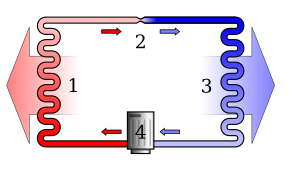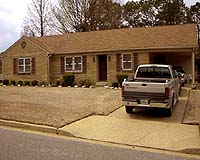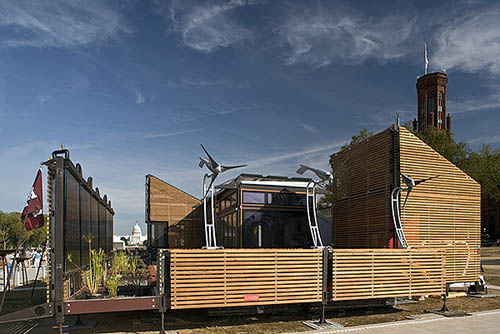OK so my energy efficient 27 inch Samsong is all set up. I looked in the paper and CSI is not new so we can go back the appliances now. As I said in the last post a truely efficient Refrigerator would have the freezer compartment on the floor, followed by the food compartment and then the compresser. It would be up against an outside wall, and there would be a system for venting the heat outside during the cooling season. I may even be able to find a drawing of one…I think it was in the original Whole Earth Catelog….whatever. Here’s what the experts say:
Buying a New Refrigerator To find the most efficient refrigerators , download a qualifying product list from the ENERGY STAR Web site (link to excel file in the upper-right). Sort by “Configuration,” “Volume,” and “Percent Better” to see which refrigerators meet our recommendations (below). For a quick search by manufacturer, here’s a direct link to the list in html.
When buying a new refrigerator, consider the following:
1. Low Annual Energy Use
ACEEE recommends that you consider models that use at least 20% less electricity than that required by federal law. Models that are 20%, 25% and 30% better than the federal standard may qualify for rebates — check with your local utility.
2. Choose top-mounted freezer configuration over side-by-side
Side-by-side refrigerator/freezers use more energy than similarly sized models with the freezer on top, even if they both carry the ENERGY STAR. The government holds the two categories to different standards, allowing side-by-sides to use 10-30% more energy. Icemakers and through-the-door ice also add to energy consumption. To compare energy performance across different refrigerator types, look for the measured “kWh/year” either on the ENERGY STAR list above, or on the yellow EnergyGuide label posted on the refrigerator (and available on-line through many manufacturers and retailers websites).
3. Size Matters
Refrigerators under 25 cubic feet should meet the needs of most households. The models over 25 cubic feet use significantly more energy. If you are thinking about purchasing such a large unit, you may want to reconsider. A smaller unit may well meet your household’s needs.
4. Minimize multiple refrigerators
That said, if you need more refrigerator space, resist the temptation of moving your old refrigerator to the basement or garage for auxiliary purposes. Instead, have it recycled and think about other options if you need more refrigerator space. Depending on your situation, it is generally much more efficient to operate one big refrigerator rather than two smaller ones. If your big fridge is likely to be empty most of the year, maybe the better option would be to purchase an ENERGY STAR compact fridge. Compact refrigerators less than 7.75 ft3 must be 20% more efficient than the minimum federal standard to qualify for ENERGY STAR. They are listed alongside full-size refrigerators at the ENERGY STAR link above.
5. Recycle your old fridge
Be sure you dispose of your old refrigerator properly. You can usually have the utility or the city pick it up; they might even pay you to throw it out. To learn more, go to our web page on appliance recycling and disposal.
:}
I you want the website and their spiel:
http://www.energystar.gov/index.cfm?c=refrig.pr_refrigerators
Residential Refrigerators
Commercial Solid Door Refrigerators & Freezers
ENERGY STAR qualified refrigerators require about half as much energy as models manufactured before 1993. ENERGY STAR qualified refrigerators provide energy savings without sacrificing the features you want.
Earning the ENERGY STAR
- ENERGY STAR qualified refrigerator models use high efficiency compressors, improved insulation, and more precise temperature and defrost mechanisms to improve energy efficiency.
- ENERGY STAR qualified refrigerator models use at least 20% less energy than required by current federal standards and 40% less energy than the conventional models sold in 2001.
- Many ENERGY STAR qualified refrigerator models include automatic ice-maker and through-the-door ice dispensers. Qualified models are also available with top, bottom, and side-by-side freezers.
- ENERGY STAR qualified freezer models use at least 10% less energy than required by current federal standards. Qualified freezer models are available in three configurations:
- upright freezers with automatic defrost
- upright freezers with manual defrost
- chest freezers with manual defrost only
- ENERGY STAR compact refrigerators and freezers use at least 20% less energy than required by current federal standards. Compacts are models with volumes less than 7.75 cubic feet.
Remember, saving energy prevents pollution. In most households, the refrigerator is the single biggest energy consuming kitchen appliance. Replacing a refrigerator bought in 1990 with a new ENERGY STAR qualified model would save enough energy to light the average household for nearly four months.
You may also be interested to know that you can reduce the amount of energy your refrigerator or freezer uses, whether with a standard or an ENERGY STAR qualified model:
- Position your refrigerator away from a heat source such as an oven, a dishwasher, or direct sunlight from a window.
- To allow air to circulate around the condenser coils, leave a space between the wall or cabinets and the refrigerator or freezer and keep the coils clean.
- Make sure the door seals are airtight.
- Keep your refrigerator between 35 and 38 degrees Fahrenheit and your freezer at 0 degrees Fahrenheit.
- Minimize the amount of time the refrigerator door is open.
- Recycle older or second refrigerators.
:}
Then there are the Propane Refrigerators:
http://www.oasismontana.com/refrigerator.html
Propane Refrigerator by Servel
one of the oldest and most reliable manufacturers of LP units, are still available without significant lead time, for $1195 plus freight. The Servel Americana 400 series is their latest technology of fully independent refrigerator/freezers. The absorption-type cooling system (no freon) is quiet and dependable, with no compressor or other moving parts to wear out. Choose almond or white for exterior finish with designer beveled edges; 7.5 cu ft (5.6 ‘fridge, 1.9 freezer). CFC-free. Outside dimensions: 63.5″ tall; 23″ wide; depth of 26.5″. Door hinged on right. Features include all-white interior with adjustable, removable shelves and door bins, plus two vegetable crispers and a battery powered interior light. All models can be operated on AC electricity if desired (but are not energy efficient used in this fashion, using almost 4000 watts per day). Fuel consumption averages (at 77° ambient temperature) 1.1 lb of propane daily or 1.5 to 2.4 gallons per week. Swedish made with famous European craftsmanship, these units will provide many years of use. American Gas Association approval, of course; one year warranty. Call for your freight on these units. Also available as fueled by kerosene for $1550. The kerosene units do require additional maintenance (as kerosene is a less clean fuel than propane). There is a maintenance kit suggested for those interested in the kerosene units that costs an additional $149; spare parts included are 12 wicks, wick raiser, flame spreader, wick cleaner, and glass chimney.Click here for a picture and additional information on these great units .
Full Sized Propane Refrigerators Now Available
The Crystal Cold! (click this link for more data). Made by the Amish for the Amish, who usually have large families and demand high performance. White, bisque, stainless steel & black colors are available in some models. Click here for more details. These units look like a ruggedly-built, conventional refrigerator, available in 12 cu .ft , 15 cu ft, 18 cu ft, and now a whopping 21 cu. ft. model. Runs on natural or LP gas, very gas efficient; one year warranty, with option to extend warranty to three years for $65. For natural gas conversion at the factory, add $50. Call, write or e-mail us for additional information on these quality NEW units.
:}
Made by the Amish for the Amish. I love it. Lord there is hope. Then there are the solar people:
Full Sized Propane Refrigerators Now Available
The Crystal Cold! (click this link for more data). Made by the Amish for the Amish, who usually have large families and demand high performance. White, bisque, stainless steel & black colors are available in some models. Click here for more details. These units look like a ruggedly-built, conventional refrigerator, available in 12 cu .ft , 15 cu ft, 18 cu ft, and now a whopping 21 cu. ft. model. Runs on natural or LP gas, very gas efficient; one year warranty, with option to extend warranty to three years for $65. For natural gas conversion at the factory, add $50. Call, write or e-mail us for additional information on these quality NEW units.
http://www.partsonsale.com/sundanzer.html
Remote home and cabin owners, are you aware that it takes ten 85 watt solar panels with their associated mounting brackets, wire, charge controller, combiner box, inverter, inverter cables, battery cables, fusing and a fairly large bank of deep cycle batteries to power a conventional 600 watt refrigerator !

Save on system costs with these Ultra High Efficiency battery-powered solar refrigerators and freezers. These highly efficient units with exceptionally low energy consumption require a smaller photovoltaic (PV) system for your refrigeration needs. these Ultra High Efficiency units feature 4.33″ (110 mm) of polyurethane insulation and coated steel cabinets. The brushless motor compressor operates on 12 or 24 VDC. A patented low-frost system reduces frost build-up for low maintenance.these Ultra High Efficiency chest-style refrigerators and freezers are easy to clean using the drain hole at the bottom of the unit. With thick insulation and a refrigeration system optimized for solar, these Ultra High Efficiency refrigerators and freezers provide outstanding economical and reliable operation. these Ultra High Efficiency cabinets are commercially produced by one of the world’s leading appliance manufacturers.
www.geappliances.com/products/energy/
www.ecomall.com/greenshopping/icebox2.htm
www.sunfrost.com
www.blog.techsoup.org/node/411
www.ecomall.com/greenshopping/icebox2.htmp
:}
:}













